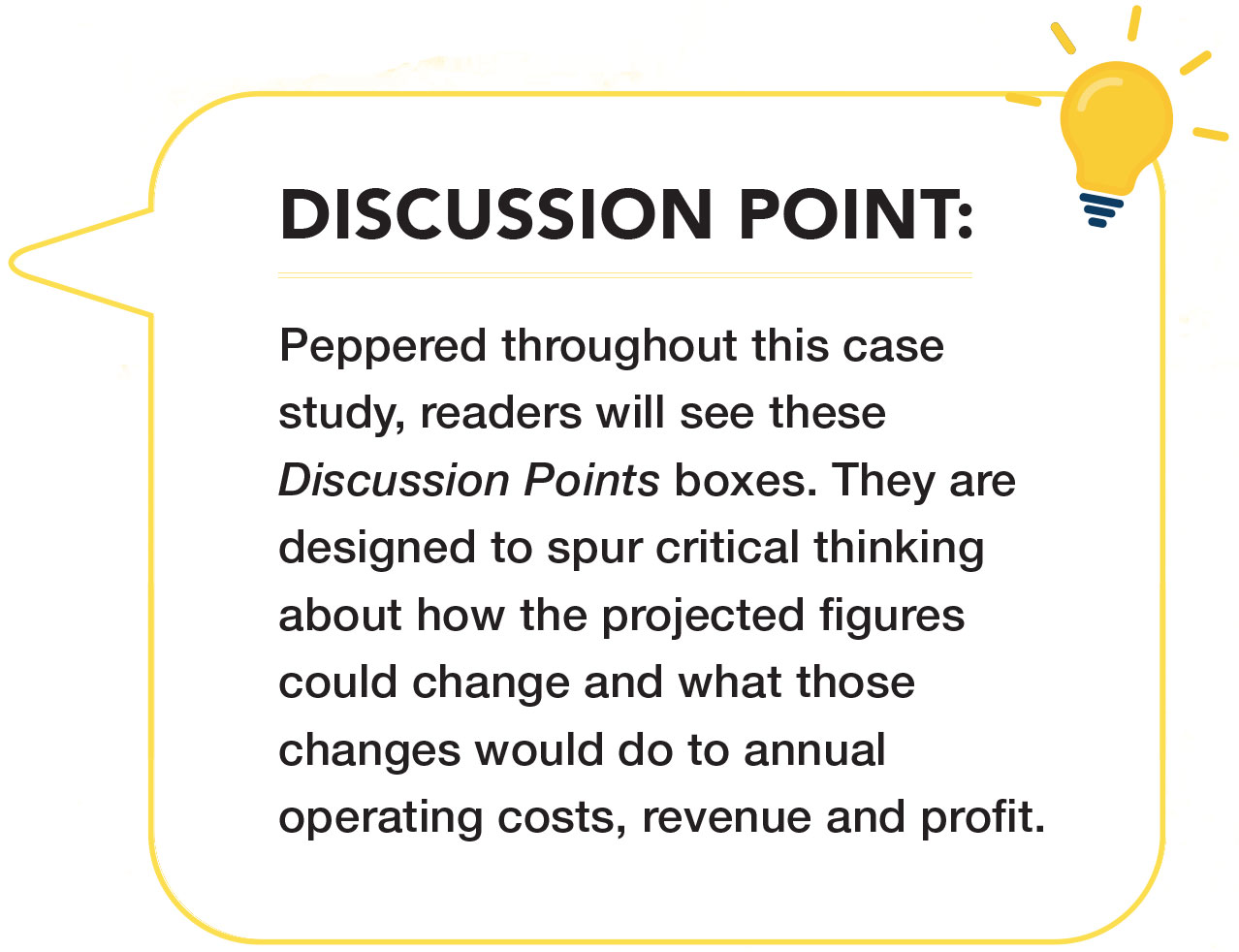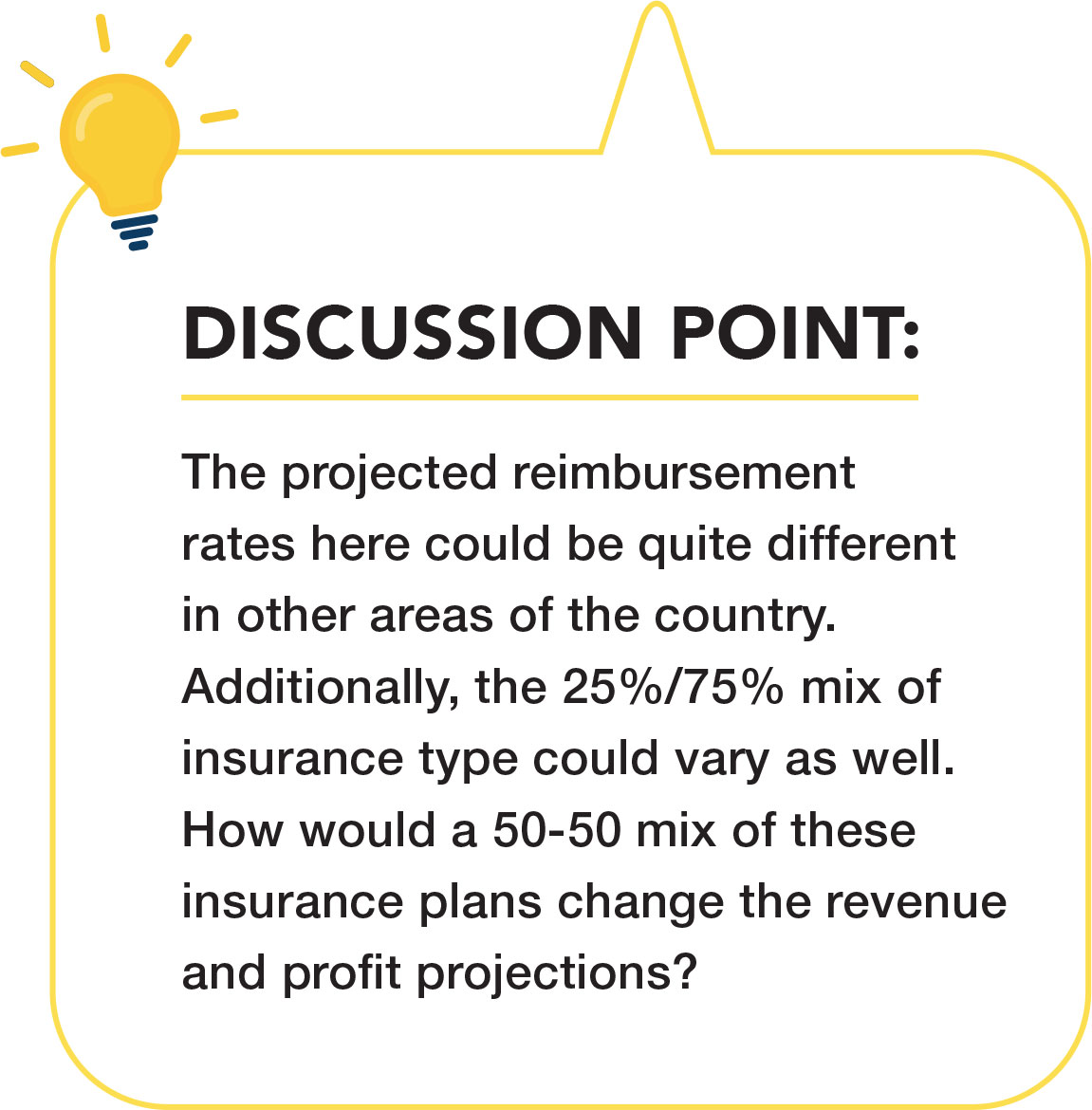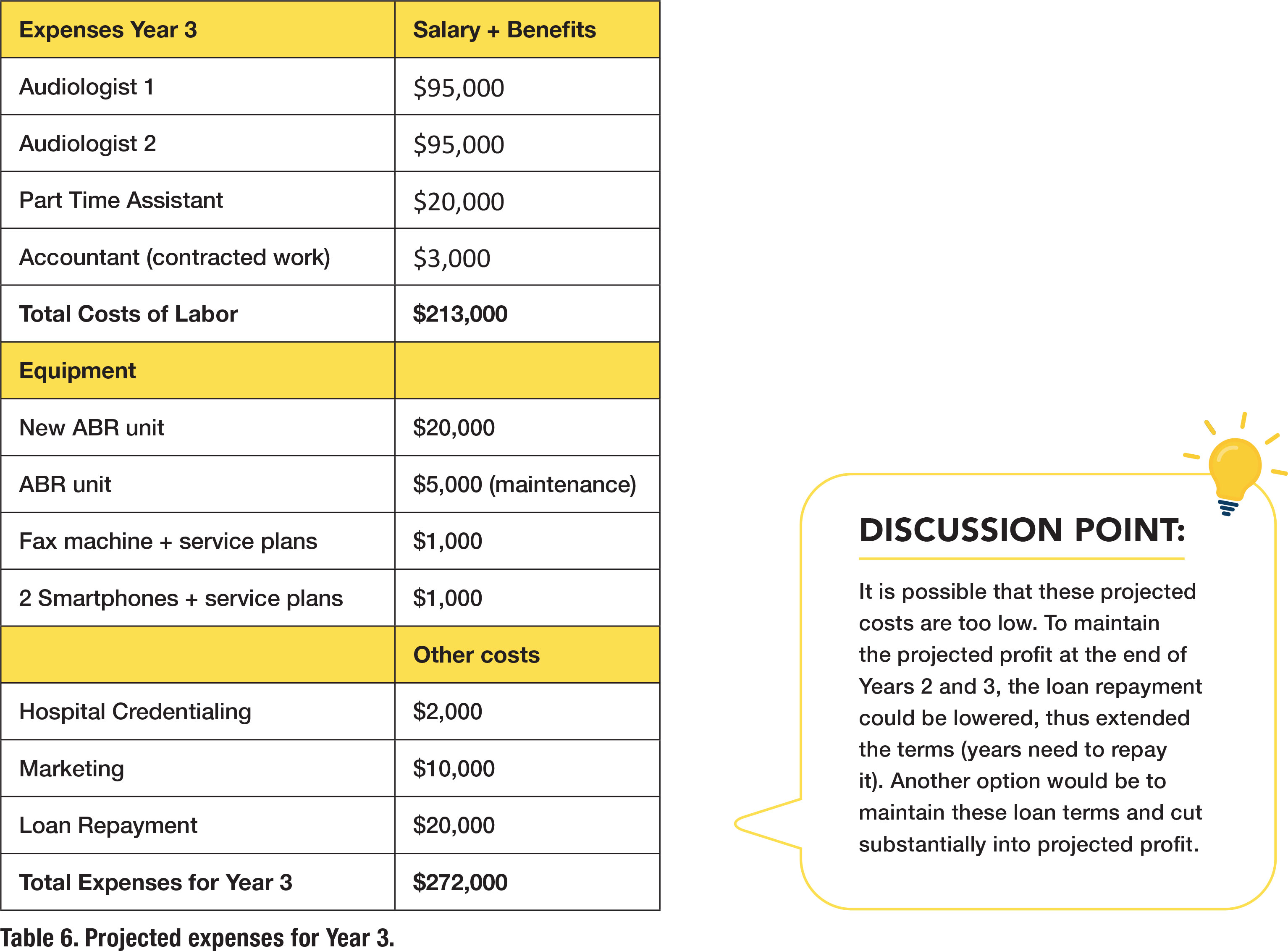
Intraoperative Monitoring Business Plan
Veronica Lane and Ally Seehafer
 Intraoperative monitoring (IOM) is performed during surgery to assess a patient’s auditory system by testing the nervous system, using evoked potentials to monitor the integrity of the auditory nerve. IOM has been a part of the scope of practice of audiologists for several years. However, few audiologists are actively involved in IOM. Here we present a case study of how an IOM practice could be started and achieve profitability within three years.
Intraoperative monitoring (IOM) is performed during surgery to assess a patient’s auditory system by testing the nervous system, using evoked potentials to monitor the integrity of the auditory nerve. IOM has been a part of the scope of practice of audiologists for several years. However, few audiologists are actively involved in IOM. Here we present a case study of how an IOM practice could be started and achieve profitability within three years.
In this case study note there are several economic advantages of an IOM practice, including the following:
- Low overhead. Because an IOM business focuses on operating room procedures, there is no cost associated with maintaining a brick-and-mortar clinic. However, in some IOM businesses the owners might be expected to pay fees associated with using the hospital.
- Marketing costs are relatively low and typically decrease over time. Because the service is provided to a finite number of surgical teams, located in specific places, once a clientele is established, there is little reason to maintain a large marketing budget.
- Equipment costs are not astronomically high. Unlike a conventional private practice that needs a booth, audiometer, immittance bridge and probe mic system, there is one large equipment investment: an ABR unit. In some cases, the hospital may have one that can be used, reducing this cost even more.
- Reimbursement rates are consistent, and the reimbursement process is relatively simple. There are just a handful of codes that are routinely used and reimbursement rates from both Medicare and other third-party administrators have been consistent over many years.
- The work is steady and rewarding. Audiologists involved in IOM typically work during surgical hours, which are very early in the morning until early afternoon, Monday through Friday, and rarely on weekends. Because IOM audiologists are part of a surgical team, they are at the forefront of many life-altering events, which can lead to a fulfilling career.
While all audiologists might find this case study informative, it is especially geared toward professors and students who are engaged in Audiology Practice Management coursework. Those readers should pay particular attention to how the case study business plan is organized as well as the financial projections and how they may differ in various ways.
Elevator Pitch
We are a team of IOM audiologists who travel throughout hospitals in Illinois, mostly throughout the Chicago area, to serve cochlear implant and acoustic neuroma/facial nerve patients who are receiving surgery. IOM requires precise skills and there is currently a lack of audiologists that solely specialize in this delicate, yet important practice, which can offer peace of mind to patients and surgeons. The presence of IOM specialists has been shown to improve the accuracy and speed of the surgery (Charalampidis, et al 2020).
The Team
We are two licensed audiologists certified by the American Audiology Board of Intraoperative Monitoring (AABIOM) (AABIOM, 2020). We have a combined 20 years of experience in medical audiology. We went through extensive supervised experiences and passed our board certification for intraoperative monitoring. Our team will also include a part-time employee (.5 FTE) to help us schedule appointments and implement marketing strategies. We will hire a tax consultant/accountant for tax season annually to assist us with our finances. By the end of year four, we plan to hire an additional AABIOM certified audiologist in Iowa to expand our business further into the Midwest.
Market Summary
This business will perform intraoperative monitoring services for two types of survey: cochlear implants and acoustic neuromas. Further, any other surgery involving preservation of the Facial nerve deemed necessary by the local hospital’s surgical staff will be part of our IOM scope of practice.
This business markets itself to the eight major hospitals of the Chicago, Illinois area (American Cochlear Implant Alliance, n.d.). These hospitals perform many of the state’s otolaryngology surgical procedures. The greater Chicago area is a medical destination for the entire state of Illinois as well as some of the surrounding states due to the high prevalence of outstanding medical facilities. Lurie Children’s is one of the largest cochlear implant centers for pediatrics and Loyola Medicine is the highest volume center for cochlear implants in the Midwest. Collectively, all eight hospitals report doing hundreds of cochlear implant surgeries since 1991, which demonstrates there is a sizeable market to support this business. Additionally, we believe cochlear implant surgeries, especially in the adult population, are poised to grow because of technological advancements and the recent expanded candidacy requirements, known as the 60-60 criteria (Zwolen et al 2022). These expanded criteria are increasing awareness in and beyond the audiology community of cochlear implant effectiveness for adults with moderately severe to profound hearing loss, who are struggling with traditional hearing aids.
According to the local head surgeons we have spoken to at the local hospitals, the national average for acoustic neuromas (combined with other similar types of neoplasms) on an annual basis is 25 surgeries per site, each lasting an average of five hours. With the increase in access to imaging procedures by patients, and the increased technology for surgical procedures, it has become more commonplace to perform these surgeries as needed. The business will primarily market to hospitals that perform these surgeries and that can significantly improve safety and accuracy with the presence of IOM. Globally, IOM is on the rise and is expected to grow over the coming years (GlobeNewswire, 2023).
Competitive Landscape & Advantage
The state of Illinois does not have any certified AABIOM audiologists. The current strategy for IOM in the state of Illinois is to have medical doctors, who have been trained in neurology, assist in these surgeries. Our business allows medical doctors to focus on their own patients and schedules, especially as many of these professionals do not have a background in otolaryngology specialties. We differentiate ourselves from other IOM services as we are experts in audiology/otology IOM procedures and offer in-person, academically trained specialists instead of in-person techs and virtual specialists. This allows for direct and immediate communication between our audiologists and the surgeons. Being the only certified AABIOM audiologists in the state of Illinois offers us an advantage to set up strong relationships between ourselves and hospitals and surgeons. The process of becoming a certified AABIOM audiologist requires two to three years of additional training and experience, creating a limited field within audiology. In addition, the vast majority of AABIOM certified audiologists work for companies like our own, as it is rare to be hired by a hospital for full time intraoperative monitoring by an audiologist. This shows our competitive advantage in the field and how our competitive advantage will last for at least several years, if not longer.
Financial Goals
 We plan to be profitable by the end of Year 2. We believe that to be profitable, we need to conduct 200 intraoperative procedures per year. Generally, we plan to divide the work evenly between the two audiologists, thus conducting 100 appointments per audiologist per year. Given the ramp up time, Year 1 will be below 200 appointments per year.
We plan to be profitable by the end of Year 2. We believe that to be profitable, we need to conduct 200 intraoperative procedures per year. Generally, we plan to divide the work evenly between the two audiologists, thus conducting 100 appointments per audiologist per year. Given the ramp up time, Year 1 will be below 200 appointments per year.
We will not have office space, greatly reducing projected annual operating costs. Also, as we are only advertising to the eight hospitals that offer these surgeries in the Chicago area, our marketing costs will be low. Our part-time employee will work from home to schedule appointments with hospitals, perform billing and coding functions, and support marketing efforts. Since the audiologists will not be spending 40 hours/week on appointments, they will also assist in marketing the business.
In Year 4, we plan on hiring another IOM audiologist who will conduct IOM appointments in Iowa which will increase our revenue and our reach further into the Midwest. We also plan on increasing the number of appointments all three audiologists will have to further increase profits. This will be achievable since we will have established ourselves in the Chicago community and will have shown our value and necessity during surgeries.
Go-To-Market Strategy
 This business is being exclusively marketed to hospitals where a high volume of head and neck surgeries are conducted. Due to this, marketing strategies will differ from typical private practice and hearing aid marketing strategies. We will focus on marketing to hospital administrators and surgeons using presentations and informational flyers and emails. For our presentations, we will combine them with a catered lunch.
This business is being exclusively marketed to hospitals where a high volume of head and neck surgeries are conducted. Due to this, marketing strategies will differ from typical private practice and hearing aid marketing strategies. We will focus on marketing to hospital administrators and surgeons using presentations and informational flyers and emails. For our presentations, we will combine them with a catered lunch.
These presentations will help us introduce ourselves, discuss our business, and present our necessity in appointments. We will discuss our certification and how we are the only AABIOM certified audiologists in the state, which shows our expertise and understanding of the patients. We will also regularly send informational flyers/emails to administrators and surgeons to show them our benefit during appointments. Since we are marketing to eight hospitals, we will cater our marketing to fit the mission statements and practices of each individual hospital. All these hospitals promote high levels of patient care, which aligns with our values. We will also discuss how we will meet all our patients prior to the surgery to talk about our role and answer any questions they may have. Our priority is emphasizing how we are clinicians that offer peace of mind for patients undergoing surgeries of all risk levels.
Another integral part of our marketing strategy will be increasing awareness within the audiology community and the general public about the value of cochlear implants in adults, with severe-to-profound hearing loss who currently wear hearing aids. We believe there is a lack of awareness among audiologists about the relatively new 60-60 CI guidelines. Therefore, we will use part of our marketing budget to host one or two local seminars for audiologists to raise their awareness on the 60-60 criteria. We believe by educating audiologists, this will lead eventually to more CI business for us in later years.
We expect 200 appointments completed during Year 2, which aligns with a typical acoustic neuroma/facial nerve and cochlear implant caseload for eight hospitals. The number of appointments completed will increase after the first year as we further establish our relationships with the hospitals.
The major benefit of having us conduct intraoperative monitoring during appointments is that we can provide input on how the auditory system is being impacted while the surgery is being done. If something happens during the appointment, such as the surgeon clamping the auditory nerve, that will show up on our auditory brainstem response testing and we could alert the surgeon of the issue so that the risk of long-term effects decrease. Our services offer more peace of mind and security for these patients and their loved ones as they are undergoing surgery.
Pricing Structure
 (How We Will Bill for Our Services)
(How We Will Bill for Our Services)
We will bill according to the 95940 CPT code which bills in 15 minutes increments. Both Medicaid and private thirdparty insurance plans reimburse for the surgical procedures in which this CPT code applies. These Illinois hospitals (and Iowa in years 4 and 5) are not heavily impacted by Medicare reimbursement rates, at least within the next three years. However, this region is not devoid of all Medicare services. Therefore, we estimate that 25% of our appointments will be with Medicare rates and 75% of our appointments will be with insurance or private pay rates. The Medicare rate is $33 per every 15 minutes, or $132 per hour. The insurance rate is an estimated $75 per every 15 minutes, or $300 per hour. Acoustic neuroma/facial nerve surgeries, on average, take five hours and cochlear implant surgeries, on average, take two hours. Thus, our IOM time corresponds with these: five billable hours for facial nerve monitoring procedures and two billable hours for IOM monitoring for cochlear implant procedures.
Financial Roadmap
To start our business, we are asking for a $75,000 small business loan from the state of Illinois. This is a special loan granted by the state to qualifying women who want to start a business. A stipulation of this loan is that if it is repaid in full within three years, there is zero interest. Next, we model the annual revenue and expenses we estimate for the first three years of our business to show how we plan to break even and repay this loan by the end of Year 3.
Projected Profit for Year 1:
In year 1, we are expected to lose money as our business gains traction. Our projected loss: -50,720


Projected Profit for Year 2:
In year 2, we expect to make a profit of $46,420. We plan to reinvest this profit back into the business by purchasing another ABR unit.


Projected profit at the end of Year 3: $61,840


Financial Roadmap Highlights
 Over the course of the first three years, we project incremental growth of our business. This is a deliberate strategy, as we plan to share one portable ABR unit between 2 audiologists. Having one unit will reduce operating costs but will force us to be highly efficient in our scheduling, as both IOM audiologists cannot be working at the same time. To improve efficiencies, we will hire a part-time administrative assistant who will plan our schedules. Over the course of the first three years, the IOM audiologists (Ally and Veronica) are job sharing, as only one will be actively monitoring at any given time.
Over the course of the first three years, we project incremental growth of our business. This is a deliberate strategy, as we plan to share one portable ABR unit between 2 audiologists. Having one unit will reduce operating costs but will force us to be highly efficient in our scheduling, as both IOM audiologists cannot be working at the same time. To improve efficiencies, we will hire a part-time administrative assistant who will plan our schedules. Over the course of the first three years, the IOM audiologists (Ally and Veronica) are job sharing, as only one will be actively monitoring at any given time.
Because we have kept expenses down, we plan to make a profit in Years 2 and 3. This enables us to do these important things at the end of Year 3:
- Repay our $75,000 loan.
- Buy a second ABR unit that enables us in subsequent years to be more efficient.
- Expand our business into Iowa by hiring another audiologist.
Risk Analysis
One significant risk is that we won’t be able to have a steady flow of appointments since we are being outsourced to various hospitals. Having a higher marketing budget in year one and focusing on a small number of hospitals will help us be able to focus on building a strong reputation with these hospitals and showing surgeons our value during surgeries. Roughly beyond year three, we could have competition as there is a possibility that other audiologists become AABIOM certified within the state. However, we will have built a reputation and relationship with the hospitals which will offer us a competitive advantage.
Summary
We are a team of IOM audiologists in Illinois who provide IOM services for cochlear implant and acoustic neuroma/facial nerve surgeries. As the only AABIOM certified audiologists in the state of Illinois, we strive to provide high quality services to patients and collaborative care for surgeons during complex operations. IOM services are on the rise as patients and surgeons desire improved safety and technology, and a reduction in risks during surgeries. We expect a gradual increase in profit within Years 2 and 3, with a net profit at the end of Year 3 of about $60,000. Since our services are in high demand, we plan on growing our business to expand further into the Midwest, improving our reach and our profits. ■
References
- American Audiology Board of Intraoperative Monitoring (AABIOM, 2020). Specialist listing. https://www.aabiom.com/_files/ugd/52165a_ 464af95bcb374e76b7d05eec78c76e21.pdf
- American Cochlear Implant Alliance (n.d.). Cochlear implant clinics: Illinois.https://www.acialliance.org/page/Illinois/Cochlear-Implant- Clinics-Illinois.htm
- Charalampidis A, Jiang F, Wilson JRF, Badhiwala JH, Brodke DS, Fehlings MG. The Use of Intraoperative Neurophysiological Monitoring in Spine Surgery. Global Spine J. 2020 Jan;10(1 Suppl):104S-114S
- GlobeNewswire (2023). Global intraoperative neuromonitoring (IONM) market report 2022 to 2027: Industry trends, share, size, growth, opportunities, and forecasts. https://www.globenewswire.com/en/news-release/2023/01/19/2591527/28124/en/Global-Intraoperative-Neuromonitoring- IONM-Market-Report-2022-to-2027-Industry-Trends- Share-Size-Growth-Opportunities-and-Forecasts.html
- Zwolan, T. A., Schvartz-Leyzac, K. C., & Pleasant, T. (2020). Development of a 60/60 Guideline for Referring Adults for a Traditional Cochlear Implant Candidacy Evaluation. Otology & neurotology : official publication of the American Otological Society, American Neurotology Society [and] European Academy of Otology and Neurotology, 41(7), 895–900.
Veronica Lane and Ally Seehafer are students in the University of Wisconsin Audiology Consortium, a program offered jointly by the UW–Madison Department of Communication Sciences and Disorders and the UW–Stevens Point School of Communicative Disorders.
